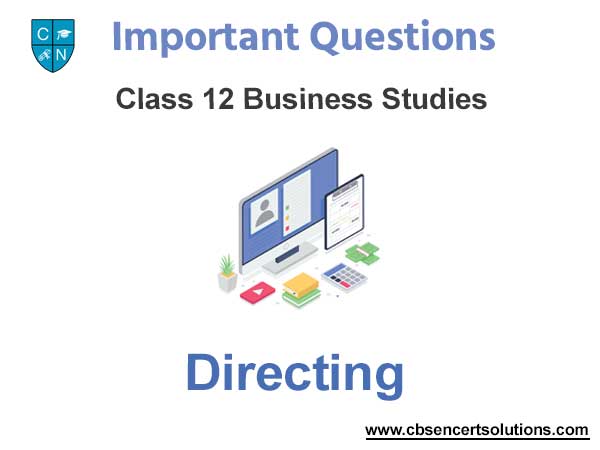Please refer to Chapter 7 Directing Case Study Questions with answers provided below. We have provided Case Study Questions for Class 12 Business Studies for all chapters as per CBSE, NCERT and KVS examination guidelines. These case based questions are expected to come in your exams this year. Please practise these case study based Class 12 Business Studies Questions and answers to get more marks in examinations.
Case Study Questions Chapter 7 Directing
Read the source given below and answer the following questions :
Incentive can be defined as monetary or non-monetary reward offered to the employees for contributing more efficiently. Incentive can be extra payment or something more than the regular salary or wage. Incentive acts as a very good stimulator or motivator because it encourages the employees to improve their efficiency level and reach the target.
Questions :
Question. To motivate employees to perform to their best level, managers use:
(a) Incentives
(b) Punishment
(c) Performance appraisal
(d) None of the above
Answer
A
Question. Incentives are:
(a) Salary increment
(b) Extra Reward
(c) Bonus
(d) All of the above
Answer
D
Question. Which function of management offers incentives to employees?
(a) Planning
(b) Organising
(c) Staffing
(d) Directing
Answer
D
Question. Incentives can be
(a) Monetary
(b) Non-monetary
(c) Both (a) and (b)
(d) None of the above
Answer
C
Read the source given below and answer the following questions :
Rajiv is working as Personnel Manager in a company. The speciality of the company is that financial position of all the employees is good. The employees working here are honest, punctual and hardworking. The CEO of the company asked him to suggest a method of motivation. The CEO asked him to suggest a method which is happily accepted by all the employees. Rajiv spoke to many employees in this connection. Some employees suggested give more importance to individual autonomy, another suggested good performance should be appreciated, another group suggested to award, certificate, trophies to recognise the good performance. Mr. Rajiv mixed all and suggested a method of motivation to CEO. The CEO happily accepted that and it was immediately implemented. Within few days the company’s growth rate appeared to have become fast.
Questions :
Question. Which motivation method combines all the above stated and was suggested by personal manager?
(a) Employee participation
(b) Organisational climate
(c) Perks and fringe benefits
(d) Recognition
Answer
B
Question. Differential piece wage technique of scientific management is example of which incentive?
(a) Employee participation
(b) Retirement benefits
(c) Productivity linked with wages
(d) Employee Recognition
Answer
C
Question. Identify the function of management indicated in above para.
(a) Planning
(b) Organising
(c) Staffing
(d) Directing
Answer
D
Question. The group which suggested award, certificate, trophies is indicating which incentive?
(a) Employee Participation
(b) Employee Recognition
(c) Productivity linked with wage/incentive
(d) Autonomy
Answer
B
Read the source given below and answer the following questions :
The communication process begins when sender thinks of an idea or message to be conveyed to other person. Then the sender encodes the message, i.e., plans out the words or the language in which the message must be sent to the other party. After encoding the message the sender transmits or transfers the message by using different ways and means. After transmission the message reaches to receiver. The receiver decodes the message to understand the message and give his response or feedback to the sender. When the feedback reaches back to sender then only the communication process ends which means the communication is a circular process which starts with sender and ends with sender.
Questions :
Question. The response of receiver to sender is called :
(a) message
(b) feedback
(c) encoding
(d) decoding
Answer
B
Question. Communication is :
(a) a two way process
(b) circular process
(c) both (a) and (b)
(d) none of the above
Answer
C
Question. Converting the messages into language is called :
(a) encoding
(b) decoding
(c) noise
(d) all of the above
Answer
A
Question. Understanding the message is called :
(a) encoding
(b) decoding
(c) noise
(d) none of the above
Answer
B
Read the source given below and answer the following questions :
Mr. Sunil Diali is a safety officer in a reputed PSU sector ECL. He supervises the workers towards the predetermined goals of the organisation and directs how to eradicate unsafe practices of inundation, fire breakouts, existence of inflammable gases etc. On one such instances there was huge fire breakout in the underground mines and the workers morale was down and demotivated because of several risk hazards. Mr. Diali observed the whole situation and consulted with all his workers and constantly monitored, guided and inspired them to integrate their efforts and accept the situation as a challenge and take adequate safety measures for fire extinguish and subsidizingits effects. Thereby, production turnover was outstanding and out performed other subsidiaries. Mr. Diali was recognised with Bravery Award from CIL.
Questions :
Question. Bravery award is ___________ form of non-financial incentive.
(a) Status
(b) Job security
(c) Career Advancement
(d) Employee recognition
Answer
D
Question. Mr. Diali consulted with all his workers, he listened to their opinions. Which form of leadership is identified here ?
(a) Laissez-faire
(b) Autocratic
(c) Democratic
(d) Free-rein
Answer
C
Question. Under Maslow’s hierarchy need theory which need of Mr. Diali has been met through respect and recognition among other employees?
(a) Self – Actualization need
(b) Safety and security needs
(c) Esteem needs
(d) Physiological needs.
Answer
C
Question. Mr. Diali worked towards predetermined goals of the organization .Which important function of directing is addressed here ?
(a) Means of motivation
(b) Initiates action
(c) Facilitate change
(d) Brings stability
Answer
B


